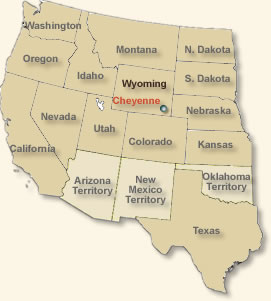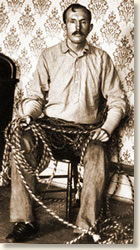|
The Hanging of Tom Horn, 1903
America's Western Frontier was officially declared closed by the US Government in 1890. However, it can be plausibly argued that the Old West, the nation’s final frontier where law and order were often home-spun enterprises, died with the execution of Tom Horn in Cheyenne, Wyoming on November 20, 1903. Tom was sentenced to death for the murder of a fourteen-year-old boy. At the time, he was working as an assassin for the local cattlemen attempting to enforce their control of the open range of southeastern Wyoming against the growing number of rustlers and sheep headers in the area.

The American West in 1903 |
Tom Horn had made his way from his birthplace in Missouri to the wilds of the Southwest in 1876, when was sixteen. He soon found employment as a scout with the U.S. Cavalry and took part in the search for the Apache Chief Geronimo. It was during this period that he perfected his skills with firearms and tracking. By 1887 Tom was out of the Army and a participant in in the Arizona Territory’s Pleasant Valley War: a feud between two families (the Grahams and the Tewksburys) that began in 1882 and lasted over ten years. By 1890, Tom was in the employ of the Pinkerton Detective Agency and tasked with tracking and finding various suspected lawbreakers. He was quite proficient at this, however, he lost his job because, more often than not, his targets were dispatched on the spot instead of returned to the courts for justice.
From 1895 to 1901, Horn worked as an "enforcer" for the large cattle interests in Colorado and Wyoming. He was charged with the task of tracking down and "dealing justice" to those suspected of stealing cattle or encroaching on their range. Horn’s “justice” was delivered by a bullet fired by his 30-30 Winchester carbine from a concealed position. Horn was on such a mission on the morning of July 18, 1901 in the Iron Mountain region of south-eastern Colorado. His intended target was Kels B, Nickell, a rancher who had brought sheep onto the range. Horn had studied his victim and was familiar with his routine. In the early morning hours, Horn nestled in a group of rocks overlooking the entrance of the Nickell’s ranch He saw his victim approach the gate and dismount. Horn rose from his concealed position and aimed his rifle. Suddenly, he realized that the person in his rifle sights was not his intended victim. It was his fourteen-year-old son, Wille, wearing his father’s hat and coat. Seeing Horn, the boy whirled and ran. After an instant of indecision, Horn fired a series of shots and watched the boy collapse to the ground, dead.
There were no witnesses to the murder. Tom Horn could have escaped justice if it were not for the extraordinary detective work of the legendary, Old West lawman, Joe LeFores who tricked Horn into confessing his crime. Horn was tired and convicted on October 24, 1902.
The following eyewitness account of the hanging of Tom Horn was writen by John Charles Thompson, a repoter. His account was originally published in the Denver, Colorado, Posse of Westeners. Horn was executed with a new, and supposedly, more humane, method of hanging that relied on the emptying of a bucket of water to trigger the release of the trap door upon which the condemned man was standing:
"We newspapermen were crammed into a little space at the edge of the platform adjoining Horn's cell; the visiting sheriffs were marshaled on the first-tier level below. The Irwin brothers, flanked by guards, stood beside them. The executioners and a venerable Episcopal clergyman, Dr. George C. Rafter, an acquaintance of Horn, were on the gangway at the opposite edge of the platform. Beside the Irwins stood two physicians, Dr. George P. Johnston and Dr. John H. Conway. They were gentlemen of the highest integrity whom nothing could have induced to contribute to a criminal conspiracy.
Horn, his back against the cell grill, was half-reclining on his narrow bed, puffing a cigar. He was perfectly composed. His soft shirt was unbuttoned at the collar, this exposing the scar of the wound he had suffered in a fight at Dixon.
'Ready Tom,' said Proctor.
Horn arose, carefully placed his cigar on a cross reinforcement of the grill, strode firmly the few steps required to take him to the side of the gallows platform.
He nodded to the Irwins; sardonically scanned the peace officers below.
Ed,' he commented to Smalley, 'That's the sickest looking lot of damned sheriffs I ever seen.
'Would you like us to sing, Tom?' asked Charlie Irwin. ‘Yes, I'd like that,' responded Horn.
So, while Proctor buckled straps that bound Horn's arms and legs, the Irwins, each in a rich tenor, sang a rather lugubrious song popular on the range, Life Is Like a Mountain Railroad.
The clergyman read his church's prayer for the dying Horn, standing relaxed, listened without a tremor.
‘Would you like to say anything?' asked Smalley.‘No,' replied Horn.
‘Tom,' spoke up Charlie Irwin, ‘did you confess to the preacher?
No,' was the reply

Tom Horn awaits
his execution, 1903 |
Proctor adjusted the noose, formed with the conventional knot of 13 wraps, to Horn's neck; drew a black hood over his head. Smal¬ley on one side and a friend of Horn, T. Joe Cahill, on the other, lifted the doomed man onto the trap.
Instantly the sibilant sound of running water permeated the breathless stillness; the instrument of death had begun to operate. To the straining ears of the listeners that little sound had the magnitude of that of a rushing torrent.
Smalley, his face buried in the crook of an arm resting against the gallows tree, was trembling.
‘What's the matter,' came in a calm tone through the black cap, getting nervous I might tip over?’
Seemingly interminable, the sound of escaping water ran on.
‘Joe,' said Horn, addressing Cahill, ‘they tell me you're married now. I hope you're doing well. Treat her right.'
Indubitably, he was the best composed man in that chamber of death.
Still the sinister sound of running water; then mercifully, the leaves of the trap parted with a crash and Horn's body hung through the opening.
Thirty-one seconds had elapsed since he had been lifted onto the trap!
He fell only four and one-half feet; his head and shoulders projected above the gallows floor. This drop was not sufficient; his neck was not broken. Proctor had feared to arrange a longer drop, apprehensive that stoppage of the fall of a body so heavy as Horn's might tear the head off. The slam of the massive hangman's knot against the side of Horn's skull knocked him into unconsciousness, however, and he did not suffer. For seventeen minutes the physicians with fingers on his pulse, felt impulses as a mighty heart labored on; then the pulse ceased.
Tom Horn was dead – unconfessed!"
References:
This eyewitness account appears in Krakel, Dean, The Saga of Tom Horn (1954, 1982); Carlson. Chip, Tom Horn: Blood on the Moon - Dark History of Murderous Cattle Detective (2001).
How To Cite This Article:
"The Hanging of Tom Horn, 1903" EyeWitness to History, www.eyewitnesstohistory.com (2012).
| 





